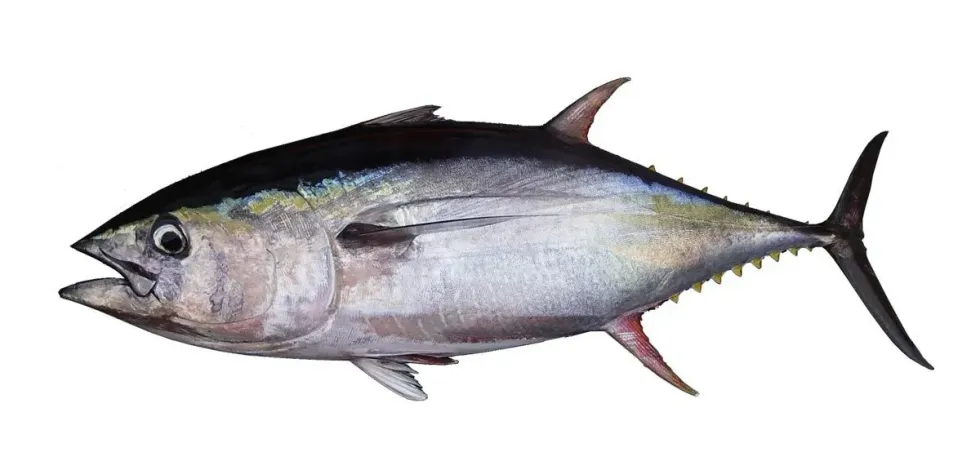Whether or not you have tasted it, you have probably heard about the tuna fish. Tuna sandwiches are among the most famous, actually.
But who knew that the delicious Tuna has a specific species which is almost 100 times bigger than regular tuna fish! The yellowfin tunas are among the largest tuna species of fish.
In Hawaii, these fish are known as Ahi. The gorgeous yellowfin tuna is torpedo-shaped, has a dark blue back, a silver belly, and anal fins and finlets are bright yellow-colored. In most species, the dorsal and anal fins are of the same color.
However, in some of the specimens, the dorsal and anal fins can be of silver color with yellow edges. Many fishing-related advertisements target the yellowfin tuna species due to their unusual and beautiful color combination.
The yellowfin tuna species, unlike the bigeye tuna species, are considered to be highly migratory. They are found across three oceans. To learn more yellowfin tuna facts, keep on reading.
For more relatable content, check out our piranha fish and milkfish facts.
Yellowfin Tuna Interesting Facts
What type of animal is a yellowfin tuna?
The yellowfin tuna is a larger species of regular tuna fish. They belong to the Scombridae family.
What class of animal does a yellowfin tuna belong to?
Yellowfin tuna (Thunnus albacares) belongs to the Actinopterygii class. Members of this class are also known as ray-finned fishes. The reason behind the unique name of these fishes is that the fin of these fishes is actually a web of skin supported by a bony structure.
How many yellowfin tunas are there in the world?
The exact number of yellowfin tuna fishes left in the world is unknown. However, this particular species of fish come under the Near-Threatened group of conservation. It means, if not protected, there is a chance for this species to go extinct.
Where does a yellowfin tuna live?
The yellowfin tuna (Thunnus albacares) is mostly found offshore, more precisely in the near-surface waters. Tropical and subtropical oceans around the world is where they are found.
What is a Yellowfin Tuna's habitat?
The most well-known habitat of the fish is the underwater seamounts and mid-ocean islands of the Caribbean, Pacific Ocean, and the Maldives. The yellowfin tuna is known for being a highly migratory fish and can take up long-range migrations.
Who do yellowfin tunas live with?
The yellowfin tuna lives in schools. It means they live with other individuals of the yellowfin tuna species and roam around the ocean in large groups.
How long does a yellowfin tuna live?
The yellowfin tuna species have a life expectancy of 6-7 years.
How do they reproduce?
The spawning of the yellowfin tuna can expand throughout the year. However, the summer months are ideal for spawning. Thus, peak spawning takes place during this time.
The male and female fishes lay eggs and sperms on the surface of the ocean water, for external fertilization. A female yellowfin tuna can lay 4 million eggs at one time. However, the number of eggs varies depending on the size of the yellowfin tuna.
What is their conservation status?
The yellowfin tuna is a Near Threatened species. This species of tunas make up a prominent part of the marine world. Thus, conservation of the species is important, otherwise there is a chance that they may become extinct.
Yellowfin Tuna Fun facts
What do yellowfin tunas look like?

Found in the sea, yellowfin tuna is also hugely eaten as delicious seafood. The yellowfin tuna is quite a large fish.
They grow up to 10.5 in -20.5 in (26.7 cm - 52 cm) long and can weigh somewhere around 400 lb (180 kg). However, apart from their strikingly huge size, the yellowfin tuna is among the most gorgeous looking tunas.
They have a beautiful metallic blue back, that transforms into a silver belly, and yellow-colored fins, which give them their name of yellowfin tuna.
How scary are they?
Even though the yellowfin tuna does not harm humans, they are scary to look at. They are quite big in size and that might be intimidating to some people.
How do they communicate?
Similar to any other sea creature, the yellowfin tuna communicates through short pulses of sound.
How big is a yellowfin tuna?
A yellowfin tuna grows almost 100 times bigger than a regular tuna.
How fast can a yellowfin tuna swim?
Yellowfin tuna is an exceptionally fast-moving fish. They can swim at a rate of 50 mph.
How much does a yellowfin tuna weigh?
Among many other sea creatures and most fishes, yellowfin tuna is quite a large fish, weighing around 400 lb (180 kg).
What are their male and female names of the species?
The yellowfin tuna do not have separate names for the male and female species. Thus, both are called the same, that is the yellowfin tuna.
What would you call a baby yellowfin Tuna?
There is no specific name for the baby yellowfin tunas. Thus, they go by the name of the parent species, in this case, it is fish. Baby fishes are called fry.
Do humans eat them?
Yes, yellowfin tuna is eaten by humans. In fact, they are considered to be a delicious seafood. However, the yellowfin tuna is high in mercury, therefore, it should be eaten in limitation to avoid any harm to health.
Also, when it comes to eating tuna fish, the albacore tuna is more popular for its exquisite taste and smooth texture. The yellowfin tuna has a pleasant taste, but the texture is not quite as fine.
Are they dangerous?
The yellowfin tuna indeed is dangerous to swarm fishes. However, it does not pose any threat to humans, as they are picky eaters and it is very unlikely for a man to get eaten by a tuna.
Would they make a good pet?
The sea creature's most common habitat is not suitable for turning them into good pets. As clear as it is, their natural habitat consists of an open ocean, which puts them way off from becoming good pets. Apart from that, these fishes can grow huge in size, making it impossible to keep them as pets.
Did you know...
A Mexican named Guy Yacom holds a world record for the yellowfin tuna record. What does it mean you ask? Well, according to IGFA (International Game Fishing Association), on September 18, 2012, Guy Yaxom caught the biggest yellowfin tuna weighing in at 427 lb (193.6 kg) using a rod and reel.
It is quite difficult to catch yellowfin tunas. Mostly, only one tiny bait is used to catch them. According to the daily retention limit, you can catch only three yellowfin tuna in a day.
How much is a yellowfin tuna worth?
Yellowfin tuna's worth can range anywhere between $3.5 - 7 per pound.
Is yellowfin tuna the same as ahi tuna?
Ahi tuna is just another name for the yellowfin tuna. In Hawaii, the yellowfin tunas are called ahi.
Which trophic level does yellowfin tuna fill in a food chain?
The open ocean creature fills the secondary consumer level in the food chain. The yellowfin tuna preys on swarm fish, squid, and pelagic crustaceans, which makes them a secondary consumer in the food chain.
Here at Kidadl, we have carefully created lots of interesting family-friendly animal facts for everyone to discover! Learn more about some other fish including suckerfish, or codfish.
You can even occupy yourself at home by drawing one on our yellowfin tuna coloring pages.










